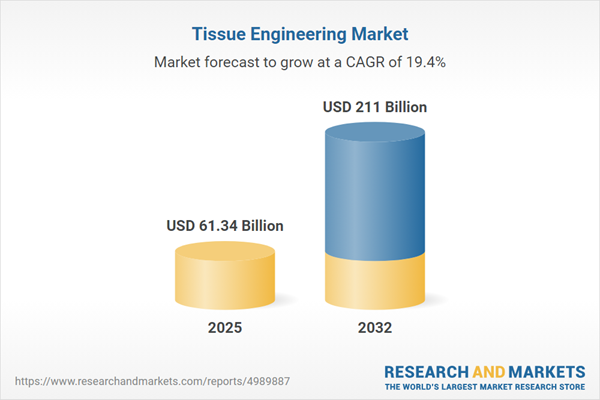Speak directly to the analyst to clarify any post sales queries you may have.
Tissue engineering is driving significant change within the regenerative medicine sector by integrating advancements across biomaterials, cell biology, and digital manufacturing. Senior decision-makers face an evolving landscape in which proactive strategic choices determine long-term positioning and growth.
Market Snapshot: Tissue Engineering Market Size and Growth
The global tissue engineering market is experiencing rapid expansion, moving from USD 51.21 billion in 2024 to an anticipated USD 61.34 billion in 2025, at a compound annual growth rate (CAGR) of 19.36%. Forward growth is expected to reach USD 211.00 billion by 2032. This trajectory is supported by increased demand for advanced regenerative therapies, continual technological advances, and the growing integration of these therapies into clinical practice. Market leaders are focusing resources on commercialization, developing novel solutions to fulfill various clinical requirements across healthcare systems.
Tissue Engineering Market Scope & Segmentation
A comprehensive understanding of tissue engineering market segmentation allows leadership teams to identify where value can be captured and to calibrate strategy for targeted execution across the following dimensions:
- Product Types: Covers therapeutic innovations in cardiovascular, neural, orthopedic and bone, and skin and wound healing segments, each with distinct clinical pathways and market potential.
- Technologies: Includes 3D bioprinting via extrusion, inkjet, and laser-assisted methodologies; cell-based tissue engineering; and decellularization. These approaches enhance manufacturing precision and adapt to varied clinical needs.
- Material Classes: Encompasses ceramic-based, composite-based, and polymer-based scaffolds, including natural and synthetic polymer options to support customized tissue responses.
- Applications: Spans broad clinical areas where tissue engineering delivers new solutions—for cardiovascular health, neuroregeneration, bone repair, and advanced skin and wound treatments.
- End Users: Considers demand and operational requirements from hospitals and clinics, OEMs, and research institutions, each playing a pivotal role in market uptake and adoption rates.
- Regional Coverage: Delivers granular analysis for the Americas, Europe, Middle East and Africa, and Asia-Pacific, evaluating trends, local dynamics, and regulatory influences that shape growth. Specific intelligence highlights North and South American developments within this larger global context.
- Key Companies Analyzed: Names such as Medtronic plc, Stryker Corporation, Terumo Corporation, Merck KGaA, Lonza Group AG, Corning Incorporated, Thermo Fisher Scientific Inc., Integra LifeSciences Corporation, Biotime Inc., and CryoLife, Inc. are thoroughly profiled, providing insight into competitive dynamics and strategic benchmarks.
Tissue Engineering: Key Takeaways for Senior Decision-Makers
- Strong cross-sector collaboration increases the pace of translating research innovations into deployable clinical products, leveraging expertise from academia, biopharma, and technology sectors.
- Integration of advanced biomaterials, evolving cell therapy platforms, and digital design tools ensures enhanced product consistency, facilitates scale, and helps in meeting regulatory demands.
- Personalized regenerative treatment modalities, supported by computational modeling and patient-derived materials, are influencing product cycles and improving outcomes with tailored therapeutic interventions.
- Resilient production and supply strategies are needed, with investments directed toward localization and diversified supplier networks to address the volatility in supply and evolving trade considerations.
- Effective intellectual property development—paired with early, proactive regulatory engagement—can accelerate approvals and mitigate compliance risk in competitive, rapidly changing markets.
- Strategic alliances and evidence-driven planning are fundamental, aligning R&D priorities with real-world demand and supporting progress through a complex regulatory environment in both well-established and emerging regions.
Tariff Impact and Supply Chain Strategies
Recent United States tariff adjustments have increased acquisition costs for critical biomaterials and equipment. As a result, many organizations are advancing nearshoring strategies, broadening supplier bases, and entering long-term procurement arrangements to safeguard against disruption. These responses also foster the development of alternative materials and drive localized production capabilities. Supportive regulatory measures and incentives are further aligning manufacturing investments with domestic innovation, resulting in more resilient and adaptive supply chains across the industry.
Methodology & Data Sources
This report draws on direct interviews with scientific, clinical, and executive leaders, supported by rigorous analysis of peer-reviewed publications, regulatory submissions, and leading industry white papers. Established frameworks such as SWOT, PESTEL, and competitive benchmarking ensure comprehensive, impartial intelligence for executive decision-making.
Why This Report Matters
- Identifies emergent opportunity areas and potential risks by product, region, and application, equipping leaders to align investments and anticipate market shifts.
- Provides the strategic insight needed to manage R&D priorities, global supply chains, and compliance needs within dynamic sector conditions.
- Delivers an integrated assessment of competitive drivers and technology trends, enabling informed decisions for both immediate tactical responses and long-term planning.
Conclusion
This report delivers the clarity senior decision-makers require to shape strategy, manage new challenges, and drive sustainable growth in the evolving tissue engineering market. Staying attentive to innovation and adaptable practices will remain central to maintaining a competitive advantage.
Additional Product Information:
- Purchase of this report includes 1 year online access with quarterly updates.
- This report can be updated on request. Please contact our Customer Experience team using the Ask a Question widget on our website.
Table of Contents
3. Executive Summary
4. Market Overview
7. Cumulative Impact of Artificial Intelligence 2025
List of Figures
Samples

LOADING...
Companies Mentioned
The key companies profiled in this Tissue Engineering market report include:- Medtronic plc
- Stryker Corporation
- Terumo Corporation
- Merck KGaA
- Lonza Group AG
- Corning Incorporated
- Thermo Fisher Scientific Inc.
- Integra LifeSciences Corporation
- Biotime Inc.
- CryoLife, Inc.
Table Information
| Report Attribute | Details |
|---|---|
| No. of Pages | 195 |
| Published | October 2025 |
| Forecast Period | 2025 - 2032 |
| Estimated Market Value ( USD | $ 61.34 Billion |
| Forecasted Market Value ( USD | $ 211 Billion |
| Compound Annual Growth Rate | 19.3% |
| Regions Covered | Global |
| No. of Companies Mentioned | 11 |









